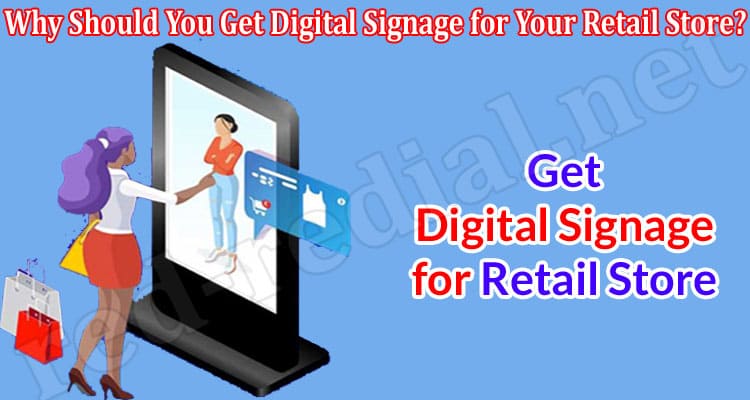Why Should You Get Digital Signage for Your Retail Store?
Digital Signage for Your Retail Store: Staying ahead of the curve—and the competition—is key to success in retail stores. Because of this, any developer looking to build a cutting-edge retail facility should give digital signage top consideration. Eighty percent of customers have entered a store solely as a result of a digital sign catching their attention. Nearly half of shoppers claim that digital displays can alter their purchasing intentions. That’s just the beginning; there are a lot more advantages for retailers, customers, and facility managers that make the investment in digital signage worthwhile.
Any public setting, including city centres and healthcare facilities, can benefit from digital signage, but retail settings stand to benefit most. Facilities need a significant differentiator to make a customer’s trip worth the effort as the pandemic continues to make people reluctant to enter brick and mortar stores. But today’s consumers demand individualised marketing and communications that are catered to their interests, not just luring visitors.
When it comes to digital signage, especially if you’re new to it, learning when and how to use this information can seem like a minefield. Digital Signage from James Hogg Display makes this process easy for new users.
As a full-service provider of solutions for digital signage, James Hogg Display was founded in 2005. They made a point of establishing themselves as a business that offered wise counsel and information to any organisations considering this novel method of advertising.
James is known as “a creative ideas man with workable results” and shares his extensive experience and skills with people who are eager to listen and learn. His creative thinking and problem-solving abilities have made him a valuable resource for people to use in their jobs.
Benefits of digital signage in retail
-
High consumer engagement
People are accustomed to always being inundated with information. This is especially true in retail environments where clients are continuously surrounded by lots of various labels, markings, and navigation cues. One of the most noticeable advantages of digital signage in retail is how it can stand out right away. More conventional signage would blend into the background if it didn’t have a dynamic image and a bright, backlit display panel.
Beyond the intrinsic allure of a lively moving image, human agency is a crucial factor to take into account when using digital signage in retail. Digital signage can respond to visitor questions through speech recognition and touch displays, offering a personalised experience that is not feasible with conventional signs.
The same signs that promote products can also serve as the first point of contact for clients who would otherwise need to approach a staff member and provide answers to typical queries. Customer information is sent more rapidly, and personnel are free to carry out their responsibilities with little interruptions. Given pandemic-related health concerns, encouraging these kinds of contactless connections is especially beneficial.
-
Data collection
In retail settings, it is essential to comprehend consumer behaviour, and digital signage plays a significant role in this. Whereas traditional signage is essentially inert, digital signage may offer insightful data on which campaigns draw the most attention, which searches get the most inquiries, and even which colours are most liked by visitors. A sign might monitor which items customers spend the most time looking at or where they are most likely to look for the exit.
Inviting users to open links on their phones with QR codes promotes continued engagement and offers a chance to learn more about them through anonymous tracking. Vendors find it very attractive to collect and analyse this data, providing your facility an advantage over the competition.
-
Source of revenue
Although it is clear that in-store marketing on digital signage has promise, it is also possible to open up that space to outside advertisers in order to diversify revenue sources. In-store placements provide an overall approach combining all factors, when combined with online ads, since advertisers are eager to have their goods and services visible in high-traffic areas.
Although there are enough possible revenue streams for digital signage to warrant its own article, it is obvious that the signs themselves do not have to be a sunk investment that will only enhance other elements of the company. With the right partners, your new signs will help to boost your revenue with little expenditure on your part.
-
Greater agility at lower cost
Although traditional signs may be less expensive initially, hidden costs start to add up as soon as it’s time to alter a location’s appearance. The first challenge is not even ordering or producing the new signs. The time taken to set up on-site and shipping significantly increases the cost. You will incur additional costs if you decide to preserve the outdated signage rather than dispose of it when it’s time to switch to new wording. Media production and consumption are time-consuming, expensive, and ineffective.
Digital signage just only a single installation and may then be updated whenever necessary. With little to no interaction from on-site workers, new designs can be implemented simultaneously at many sites. In order to maintain client interest, this enables more event- or season-based adjustments. Additionally, it makes sure that all locations have the proper signs up and running on time, which is next to impossible to guarantee otherwise.
-
Efficient staff
Important information must be communicated to employees at all levels, which becomes more challenging as a company grows in size. Digital signage can be utilised to exert more centralised control over what employees view on a daily basis, which can help prevent messages from being lost or diluted at each point of separation in terms of both hierarchy and distance. Using digital signs to display lessons or important reminders when and where they’re needed, then switching back to their regular wording once the training is complete, can assist with training personnel.
Employees can spend more time on their regular tasks since interactive displays can answer frequent enquiries from visitors. They can also concentrate on customer issues that would really benefit from their personal touch, which enhances interactions and encourages retention.




